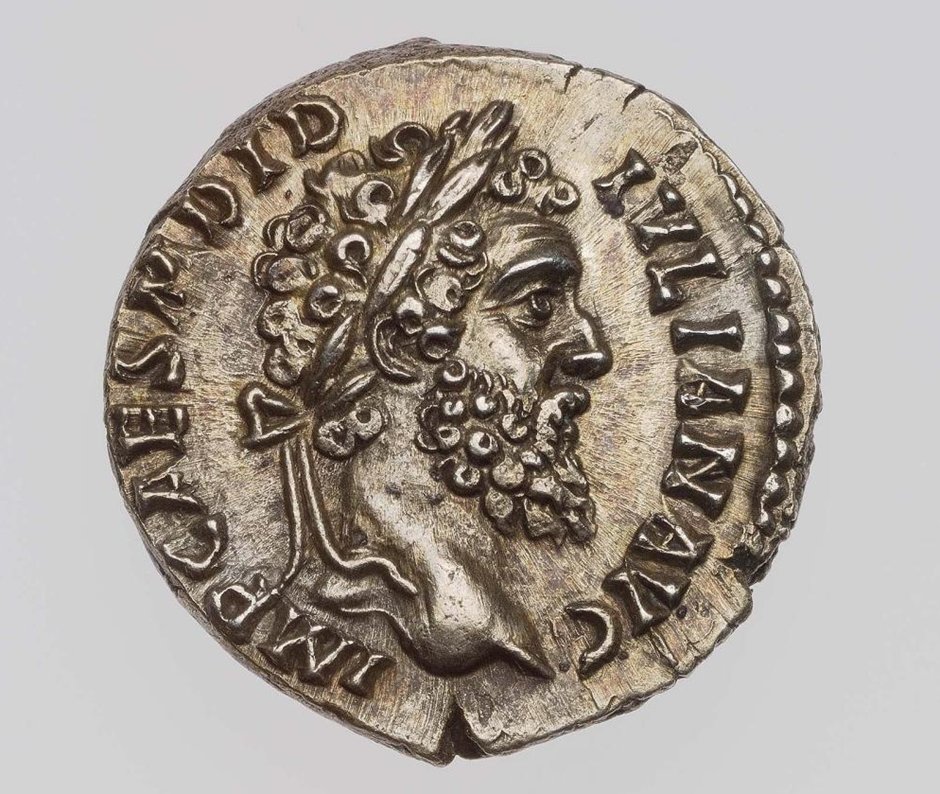Discover and read the best of Twitter Threads about #ACOTD
Most recents (24)
Ancient Coin of the Day: A gander at some coins from Britain prior to the Claudian invasion of AD 43, in particular those of Cunobelinus, the origin of Shakespeare’s Cymbeline. #ACOTD #Numismatics #Britain 🧵
Image: British Museum (1977,0434.6). Link - britishmuseum.org/collection/obj…
Image: British Museum (1977,0434.6). Link - britishmuseum.org/collection/obj…

Cunobelinus was a local British ruler who exerted control over a large area of south-east England, ca. AD 10-40, with a capital at Colchester. He claimed to be the son of Tasciovanus, who had ruled a kingdom centred to the north of the Thames.
Ancient Coin of the Day: Today is about Didius Julianus, the man who bought the position of Emperor from the Praetorian Guard on this day, 28 March, in AD 193. #ACOTD #Numismatics #Rome 🧵
Image: RIC IV Didius Julianus 1; MoFA Boston (1999.514). Link - numismatics.org/ocre/id/ric.4.…

Image: RIC IV Didius Julianus 1; MoFA Boston (1999.514). Link - numismatics.org/ocre/id/ric.4.…


Following their killing of Pertinax on 28 March AD 193, the Praetorian Guard decided to auction off the position of emperor to the highest bidder. Didius Julianus won the day, promising 25,000 sesterces per man (Dio 74.11.5), beginning his brief nine-week reign.
Ancient Coin of the Day: As today marks the beginning of the end of his reign, a quick look at some of the coins of the Roman Emperor Macrinus! #ACOTD #Numismatics #Macrinus 🧵
Image: RIC IV Macrinus 50c; Münzkabinett Berlin (18277254). Link - numismatics.org/ocre/id/ric.4.…

Image: RIC IV Macrinus 50c; Münzkabinett Berlin (18277254). Link - numismatics.org/ocre/id/ric.4.…


Marcus Opellius Macrinus briefly reigned as Roman Emperor in AD 217-218, following the murder of his predecessor Caracalla. Indeed, Macrinus - the Praetorian Prefect - was alleged to have had been the instigator of the conspiracy against Caracalla.
He was also the first emperor not drawn from the senatorial class and, given the issues of his brief reign, never had the opportunity to visit Rome.
Ancient Coin of the Day: Today’s an Othonian anniversary, so here's a quick look at the coins of M. Salvius Otho as he attempts to legitimise his rule as Roman emperor. #ACOTD #Roman #Otho 🧵
Image: RIC Otho 7; ANS 1944.100.39833. Link – numismatics.org/ocre/id/ric.1(…

Image: RIC Otho 7; ANS 1944.100.39833. Link – numismatics.org/ocre/id/ric.1(…


By far Galba’s greatest failure was never to believe that others would seek to do what he had done, i.e. seize the imperial throne. In particular, he grossly underestimated the ambitions of his erstwhile ally, the governor of Lusitania, Marcus Salvius Otho.
Otho most likely ‘tied himself to Galba’s wagon’ from the belief that the elderly princeps (Galba was already 71 at the time of his troops declaring him emperor), who was also childless, would have to declare a successor.
Ancient Coin of the Day: I’ve been remiss in coin threads this week, so let’s get back to it with this base-silver tetradrachm from Alexandria, ca. AD 66-67, one of a series celebrating Nero.
#ACOTD #Nero #Games
Image: RPC 5300/5. Link - rpc.ashmus.ox.ac.uk/coins/1/5300

#ACOTD #Nero #Games
Image: RPC 5300/5. Link - rpc.ashmus.ox.ac.uk/coins/1/5300


This is a great example of Julio-Claudian provincial coinage, part of a series of five base-silver tetradrachms that were issued by Alexandria to celebrate Nero's victories on the 'festival circuit' of Greek games.
Ancient Coin of the Day: The last few days have been a bit coin-light, so let’s get back to it with a look at some electrum issues of Thebes, starting with this hemidrachm ca. 360-340 BC. #ACOTD #Numismatics #Thebes
Image: ANS 1959.73.1. Link - numismatics.org/collection/195…

Image: ANS 1959.73.1. Link - numismatics.org/collection/195…


These fabulous coins come from a series of electrum coins issued by Thebes which is in itself interesting given the lack of gold mines in Boeotian territory, entailing that the dating of these issues has come under recent scrutiny.
Ancient Coin of the Day: Today we look at two coins from the opposing sides at the Battle of Pharsalus – starting with this denarius of Pompey the Great from 49 BC. #ACOTD #Roman #Pharsalus
Image: RRC 447/1a; British Museum (2002,0102.4425). Link - numismatics.org/crro/id/rrc-44…

Image: RRC 447/1a; British Museum (2002,0102.4425). Link - numismatics.org/crro/id/rrc-44…


The commanders of the two opposing sides at the Battle of Pharsalus – Julius Caesar and Pompey the Great – both understood the importance of coinage in the run up to the battle, not only for filling their war chests but also as propaganda.
Thus at this time we see Caesar’s famous ‘Elephant Denarius’ – on which see this earlier #ACOTD thread from back in January. The two competing coinages highlight that both parties considered themselves ‘states’.
Ancient Coin of the Day: Today’s thread is about Trajan’s building projects as commemorated on coins, starting with a sestertius of the Circus Maximus ca. AD 103-111. #ACOTD #Trajan #Buildings
Image: RIC 2 Trajan 571; Münzkabinett Wien (RÖ 8287). Link - numismatics.org/ocre/id/ric.2.…

Image: RIC 2 Trajan 571; Münzkabinett Wien (RÖ 8287). Link - numismatics.org/ocre/id/ric.2.…


While he is perhaps better known for the military aspects of his reign, it cannot be disputed that Trajan was also keenly interested in building work and infrastructure, with many of his works commemorated on the coins that he issued.
Ancient Coin of the Day: As today is quite the Neronian anniversary, let’s take a look at an interesting series of coins he issued, the Decursio sestertii of AD 62-68. #ACOTD #Nero #Decursio
Image: RIC Nero 170; Münzkabinett Berlin (18220881). Link - numismatics.org/ocre/id/ric.1(…

Image: RIC Nero 170; Münzkabinett Berlin (18220881). Link - numismatics.org/ocre/id/ric.1(…


These coins form a novel and innovative series in the final years of Nero's reign and have provoked much discussion through their martial imagery, not least because they are very much at odds with the typical Neronian depictions.
Nero is not famed for his military coinage, being for more keen to advertise peace, such as on this aureus of AD 64-65 with a Reverse featuring the Temple of Janus.
Image: RIC Nero 50; British Museum (R.6525). Link - numismatics.org/ocre/id/ric.1(…
Image: RIC Nero 50; British Museum (R.6525). Link - numismatics.org/ocre/id/ric.1(…

Ancient Coin of the Day: Today we go niche with coins commemorating Diadumenian, the son of the short-reigning emperor Macrinus, from AD 217-218. #ACOTD #Diadumenian #Macrinus
Image: RIC IV Macrinus 101; Münzkabinett Berlin (18200735). Link - numismatics.org/ocre/id/ric.4.…

Image: RIC IV Macrinus 101; Münzkabinett Berlin (18200735). Link - numismatics.org/ocre/id/ric.4.…


Macrinus, the Praetorian Prefect, was alleged to have had been the instigator of the conspiracy against Caracalla, but interestingly this tradition may have owed more to subsequent emperors, such as Elagabalus, who sought to blacken Macrinus' image for their own benefit.
Born 14 September 208, named Marcus Opellius Diadumenianus, the son of Macrinus was a potentially valuable dynastic tool for the new emperor with this coin suggesting early intentions in that regard.
Ancient Coin of the Day: Heading east today, to take a quick gander at some of the gorgeous coins produced by the Arcasids of Parthia, starting with this silver drachm of Arcases I, ca. 220-215 BC. #ACOTD #Parthia #Arcasid
Image: ANS 1991.65.1. Link - numismatics.org/collection/199…

Image: ANS 1991.65.1. Link - numismatics.org/collection/199…


The Arsacids were the ruling dynasty of Parthia from the mid-3rd Century BC until AD 224, taking their name from their founder Arsaces, who conquered Parthia ca. 238 BC, following its secession from the Seleucid kingdom.
Although autonomous coins were rapidly issued by the new dynasty, they necessarily owe much to the existing Seleucid coins, but yet were keen to communicate an idiosyncratic identity in order to distinguish the Arcasids.
Ancient Coin of the Day: A lovely Siculo-Punic silver tetradrachm, ca. 320-310 BC, showing a fusion of Sicilian and Carthaginian elements. #ACOTD #Sicily #Carthage
Image: ANS 1967.152.696. Link – numismatics.org/collection/196…

Image: ANS 1967.152.696. Link – numismatics.org/collection/196…

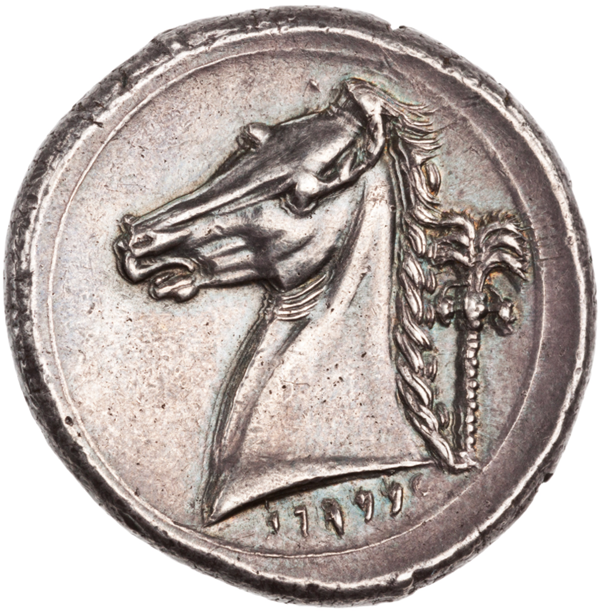
The Obverse bears a portrait of the nymph Arethusa, surrounded by dolphins, in a scene that would be familiar from the Fifth Century BC coinage of Syracuse. 

Indeed the image of Arethusa was one of the defining elements of Syracusan coin issues, as on this glorious dekadrachm from Syracuse, Sicily, ca. 470-460 BC.
Image: British Museum: 1841,0726.287. Link - britishmuseum.org/collection/obj…
Image: British Museum: 1841,0726.287. Link - britishmuseum.org/collection/obj…
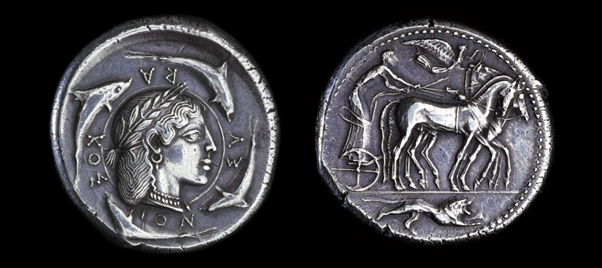
Ancient Coin of the Day: An absolutely gorgeous silver tetradrachm of Demetrius I of Bactria, ca. 2000-185 BC, with an utterly fantastic portrait bust of the man himself on the Obverse. #ACOTD #Bactria
Image: ANS 1997.9.67. Link - numismatics.org/collection/199…

Image: ANS 1997.9.67. Link - numismatics.org/collection/199…


The history of the kings of Bactria is quite confusing, primarily because our information about them is primarily derived from numismatic sources, which has necessarily caused some degree of debate about the period.
Around 245 BC, the satrap of Bactria, Diodotus I, broke from the Seleucids and established Bactria as an independent kingdom, issuing coins typical of Hellenistic monarchs, with an Obverse dominated by a diademed portrait.
Image: ANS 1980.109.108. Link – numismatics.org/collection/198…

Image: ANS 1980.109.108. Link – numismatics.org/collection/198…


Ancient Coin of the Day: A couple of days early for his birthday, but here's a sestertius of Titus from AD 80-81 showing the Flavian Amphitheatre, also known as the Colosseum. #ACOTD #Titus
Image: RIC 2.1 Titus 184; British Museum (1844,0425.712). Link - numismatics.org/ocre/id/ric.2_…

Image: RIC 2.1 Titus 184; British Museum (1844,0425.712). Link - numismatics.org/ocre/id/ric.2_…


As Titus' reign was so brief, he "achieved little remarkable" (Dio 66.25.1), but one major event that did fall within the course of his reign was the dedication of the Flavian Amphitheatre.
Ancient Coin of the Day: For his birthday, let's use today's thread to take a look at the coinage of Galba, starting with this lovely aureus of AD 68-69 from the mint at Tarraco. #ACOTD #Galba
Image: RIC Galba 40; British Museum (R.6573). Link - numismatics.org/ocre/id/ric.1(…
Image: RIC Galba 40; British Museum (R.6573). Link - numismatics.org/ocre/id/ric.1(…

Although Galba's reign was brief, he at least demonstrated that he understood the power of numismatic messaging. Thus his coinage was well-crafted with powerful messages of righting Rome and putting the empire back on track.
Ancient Coin of the Day: Just got Hercules on my mind today, so the thread is going to look at the connection which Commodus forged with Hercules, starting with this aureus of AD 190. #ACOTD #Commodus #Hercules
Image: RIC III Commodus 221d. Link - numismatics.org/ocre/id/ric.3.…

Image: RIC III Commodus 221d. Link - numismatics.org/ocre/id/ric.3.…
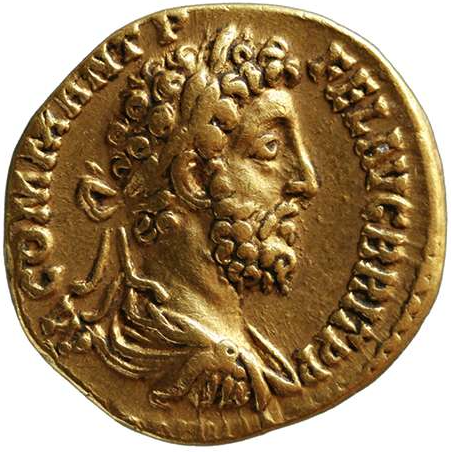
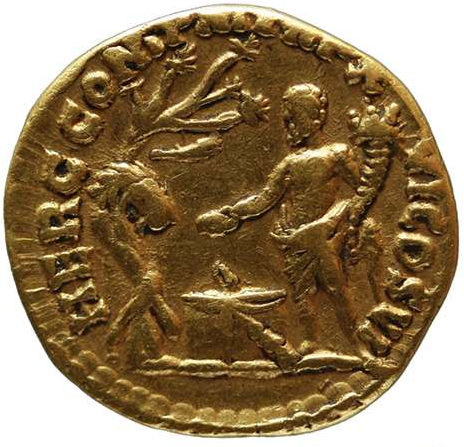
The connection between the Emperor and the gods was one that had a long history, with Augustus being worshipped at Narbonne alongside the goddess Roma, but few emperors went as far as Commodus in explicitly associating themselves with a particular deity.
Dio (73.15.6) tells us that during Commodus' reign "vast numbers of statues were erected representing him in the garb of Hercules. And it was voted that his age should be named the 'Golden Age', and that this should be recorded in all the records without exception."
Ancient Coin of the Day: A Flavian kick today, in particular the association that Domitian fostered between himself and the goddess Minerva, starting with this aureus of AD 82. #ACOTD #Domitian
Image: RIC 2.1 Domitian 138; British Museum (R.10756). Link - numismatics.org/ocre/id/ric.2_…

Image: RIC 2.1 Domitian 138; British Museum (R.10756). Link - numismatics.org/ocre/id/ric.2_…


Domitian's association with Minerva is well known, with Dio (67.1.2) noting almost immediately that "of the gods, it was Athena (Minerva) that he most honoured". Indeed, Philostratos (Life of Apollonius of Tyre 7.24) goes so far as to note that Domitian suggested that he was...
...the son of Athena. Similarly, Martial (Epigram 14.179 - published ca AD 84/5) speaks of the fact that both Minerva and Domitian sport an aegis - the Gorgon's head - on their armour. As a goddess of wisdom and warfare, Minerva was a fine choice for a close affinity.
Ancient Coin of the Day: A denarius of ca. 19-4 BC commemorating the Augustan recovery of the legionary standards from the Parthians. #ACOTD #Augustus
Image: RIC Augustus 287; British Museum (2002,0102.4941). Link - numismatics.org/ocre/id/ric.1(…
Image: RIC Augustus 287; British Museum (2002,0102.4941). Link - numismatics.org/ocre/id/ric.1(…

The loss of three Roman legionary standards under Crassus at the battle of Carrhae on 9 June in 53 BC - to say nothing of the failure of Mark Antony's Parthian Expedition in 36 BC - had long been a source of embarrassment to Roman martial reputation.
Augustus' successful diplomatic recovery of the standards in 20 BC did much to restore Roman 'dignity'. Thus unsurprisingly it was an event that featured prominently on the coinage of the period, including this denarius of Publius Petronius Turpilianus.
Ancient Coin of the Day: a quick one today, but as I've been a little lax with them of late, I feel the need. So, here's a lovely example of an early Roman denarius, ca. 211 BC. #ACOTD #Roman
Image: RRC 53/2; ANS 1937.158.571. Link - numismatics.org/crro/id/rrc-53…

Image: RRC 53/2; ANS 1937.158.571. Link - numismatics.org/crro/id/rrc-53…

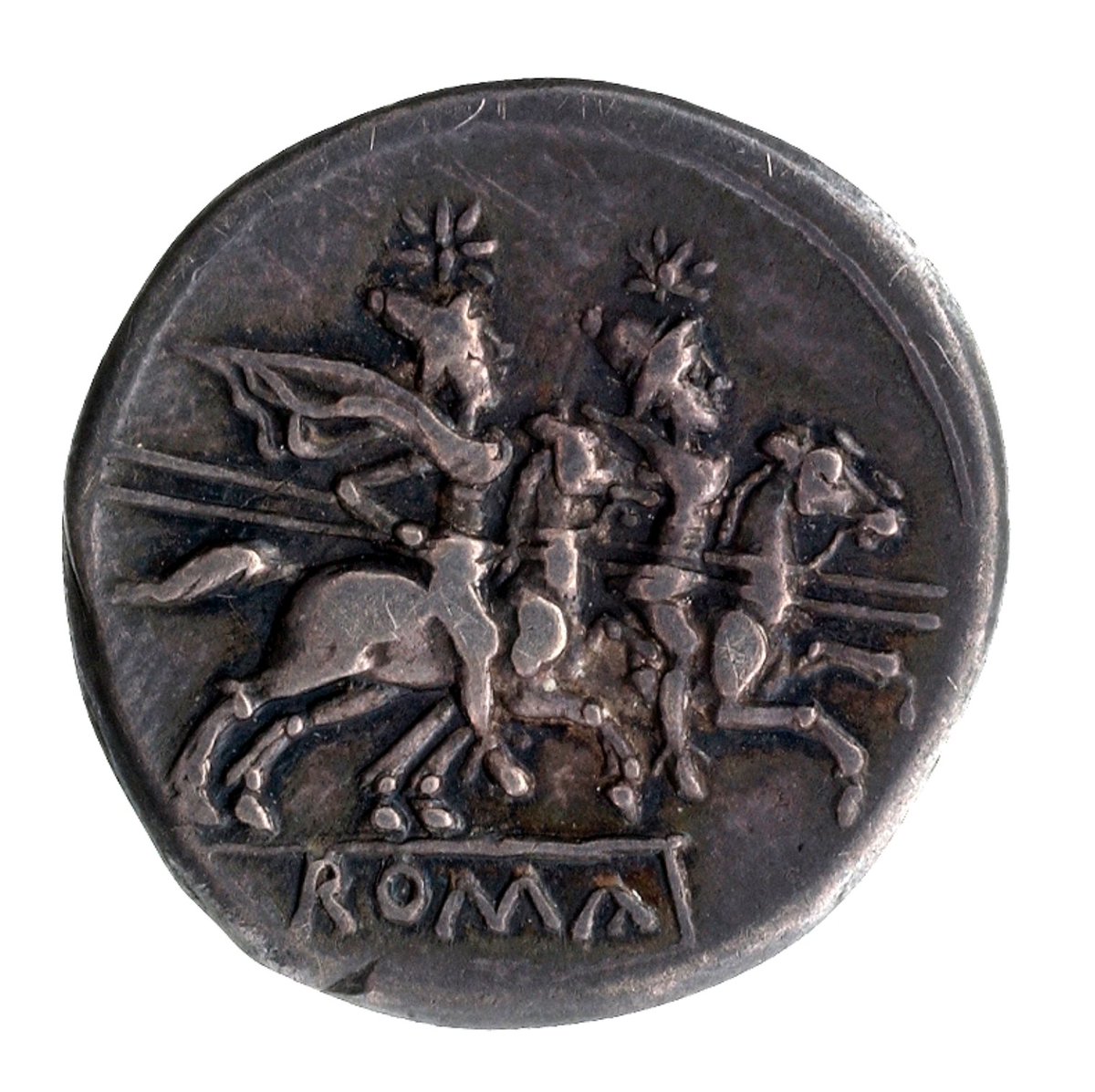
Rome's introduction of its denarius coinage has been (an continues to be in some quarters) a topic of much debate, although the extensive study of Rudi Thomsen (1957-1961: 'Early Roman Coinage - A Study of the Chronology'; 3 vols.) was, in my opinion, definitive in...
establishing 211 BC as the 'terminus ante quem' for the introduction of the denarius. Originally issued at a value of 10 asses, carrying over the system of denominational marks from the pre-existing 'aes grave' monetary system.
Ancient Coin of the Day: A bloody gorgeous aureus of AD 55, with an Obverse depicting the jugate busts of Nero and Agrippina the Younger.#ACOTD #Nero
Image: RIC Nero 6
Image: RIC Nero 6

Ancient Coin of the Day: A cracking example of Persian satrapal coinage - a silver stater minted by the satrap Tiribazus, ca. 387-380 BC. #ACOTD #Persia
Image: British Museum (GC21 (BMC Greek (Lycaonia)) (164) (12))
Image: British Museum (GC21 (BMC Greek (Lycaonia)) (164) (12))

Ancient Coin of the Day: A really lovely example of a silver tetradrachm minted by the Koinon of Athena Ilias in the Troad, ca. 188-133 BC. A remarkable form of coinage that was centred around a shared festival of Athena. #ACOTD
Image: ANS 1945.33.5

Image: ANS 1945.33.5


Long considered to be a civic coinage of Ilium (ΙΛΙΕΩΝ), this form of coinage is now understood to be the 'festival coinage' of the confederation that administrated an annual Panathenaia festival in honour of Athena Ilias.
Ancient Coin of the Day: A monster of a coin today, in sheer size at least - a bronze octobol of Ptolemy III Euergetes, ca. 246-222 BC, weighing in at 95.79g. #ACOTD
Image: ANS 1944.100.75945

Image: ANS 1944.100.75945


Ptolemy III emphasised the production of this coin, with an Obverse showing the horned head of Zeus Ammon, with the Reverse design being an eagle clutching thunderbolts in its talons.
Ancient Coin of the Day: A silver denarius of Nero, from AD 55. The Obverse is decorated with jugate busts of Nero and his mother, Agrippina. #ACOTD #Nero
Image: RIC Nero 7

Image: RIC Nero 7


The Obverse Legend, NERO CLAVD DIVI F CAES AVG GERM IMP TR P COS - 'Nero Caesar Augustus Germanicus son of Divine Claudius, hailed victorious commander, with Tribunician power, Consul, is a raft of imperial titles and official positions designed to impart legitimacy to Nero.

